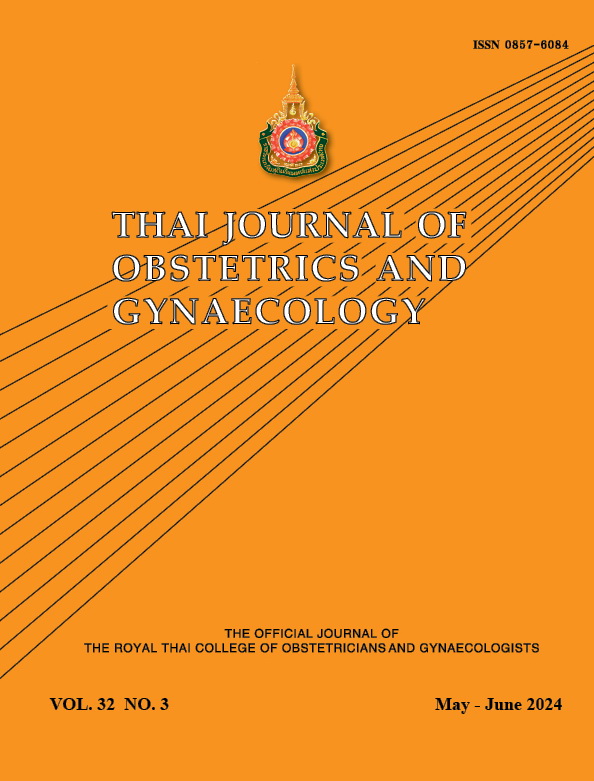Prediction of Successful Normal Vaginal Delivery by Intrapartum Transperineal Ultrasonographic Measurement of the Angle of Progression
Main Article Content
Abstract
Objectives: This study aimed to evaluate the angle of progression’s predictive ability for successful normal vaginal delivery, establishing its cutoff value and clinical application.
Materials and Methods: In this prospective, diagnostic accuracy study, we enrolled pregnant women admitted to the labor room with term singleton cephalic presentation pregnancies, excluding those at risk of undergoing cesarean delivery with indications other than cephalopelvic disproportion. The angle of progression was measured using transperineal ultrasound during the active phase of labor.
Results: A total of 114 pregnant women were included in the study. Among these participants, 102 underwent vaginal delivery (89.5%), while 12 underwent cesarean delivery (10.5%). No significant differences were observed in age, body mass index, gestational age, cervical dilatation, amniotic membrane status, or fetal birth weight among the participants. However, multiparous women displayed a tendency towards higher vaginal delivery rates than nulliparous ones. The angle of progression’s cut-off value, assessed by the area under the receiver operating characteristic curve, was 0.703. The optimal threshold on the curve, maximizing the area under the curve, was identified at 96.9 degrees, with a sensitivity of 82.4%, specificity of 58.3%, positive predictive value of 94.4%, and negative predictive value of 28% for predicting successful of normal vaginal delivery.
Conclusion: Transperineal ultrasound measurement of the angle of progression greater than 96.9 degrees showed good potential for predicting the success of normal vaginal delivery in pregnant women during the active phase of labor.
Article Details

This work is licensed under a Creative Commons Attribution-NonCommercial-NoDerivatives 4.0 International License.
References
Dupuis O, Silveira R, Zentner A, Dittmar A, Gaucherand P, Cucherat M, et al. Birth simulator: reliability of transvaginal assessment of fetal head station as defined by the American College of Obstetricians and Gynecologists classification. Am J Obstet Gynecol 2005;192:868-74.
Ghi T, Eggebø T, Lees C, Kalache K, Rozenberg P, Youssef A, et al. ISUOG Practice Guidelines: intrapartum ultrasound. Ultrasound Obstet Gynecol 2018;52:128-39.
Dückelmann AM, Bamberg C, Michaelis SA, Lange J, Nonnenmacher A, Dudenhausen JW, et al. Measurement of fetal head descent using the ‘angle of progression’ on transperineal ultrasound imaging is reliable regardless of fetal head station or ultrasound expertise. Ultrasound Obstet Gynecol 2010;35:216-22.
Tutschek B, Braun T, Chantraine F, Henrich W. A study of progress of labour using intrapartum translabial ultrasound, assessing head station, direction, and angle of descent. BJOG 2011;118:62-9.
Barbera AF, Pombar X, Perugino G, Lezotte DC, Hobbins JC. A new method to assess fetal head descent in labor with transperineal ultrasound. Ultrasound Obstet Gynecol 2009;33:313-9.
Torkildsen EA, Salvesen K, Eggebø TM. Prediction of delivery mode with transperineal ultrasound in women with prolonged first stage of labor. Ultrasound Obstet Gynecol 2011;37:702-8.
Levy R, Zaks S, Ben-Arie A, Perlman S, Hagay Z, Vaisbuch E. Can angle of progression in pregnant women before onset of labor predict mode of delivery? Ultrasound Obstet Gynecol 2012;40:332-7.
Eggebø TM, Hassan WA, Salvesen K, Lindtjørn E, Lees CC. Sonographic prediction of vaginal delivery in prolonged labor: a two-center study. Ultrasound Obstet Gynecol 2014;43:195-201.
Marsoosi V, Pirjani R, Mansouri B, Eslamian L, Jamal A, Heidari R, et al. Role of ‘angle of progression’ in prediction of delivery mode. J Obstet Gynaecol Res 2015;41:1693-9.
Pérez S, Seguer J, Pujadas A, Azuara L, Juanos J, Sagristà O. Role of intrapartum transperineal ultrasound: Angle of progression cut-off and correlation with delivery mode. Clin Obstet Gynecol Reprod Med 2017;3:1-4.
Mb V, Vinod V, Kotian C, Shah K, K Bhat S. Prediction of the mode of delivery using intrapartum translabial ultrasound in a teaching hospital in South India – A prospective observational study. Thai J Obstet Gynaecol 2022;30:41-50.
Cunningham FG, Leveno KJ, Dashe JS, Hoffman BL, Spong CY, Casey BM, eds. In: Williams obstetrics, 26th ed. New York: McGraw Hill; 2022:433-7.
Obstetric Care Consensus No. 1: Safe prevention of the primary cesarean delivery. Obstet Gynecol 2014;123:693-711.
Ghi T, Contro E, Farina A, Nobile M, Pilu G. Three-dimensional ultrasound in monitoring progression of labor: a reproducibility study. Ultrasound Obstet Gynecol 2010;36:500-6.
Brunelli E, Youssef A, Soliman EM, Del Prete B, Mahmoud MH, Fikry M, et al. The role of the angle of progression in the prediction of the outcome of occiput posterior position in the second stage of labor. Am J Obstet Gynecol 2021;225:81.e1-.e9.
Mukdee C, Suntharasaj T, Petpichetchian C. Prediction of successful normal vaginal delivery by ultrasonographic measurement of occiput-spine angle during first stage of labor. Thai J Obstet Gynaecol 2021;29:288-97.


